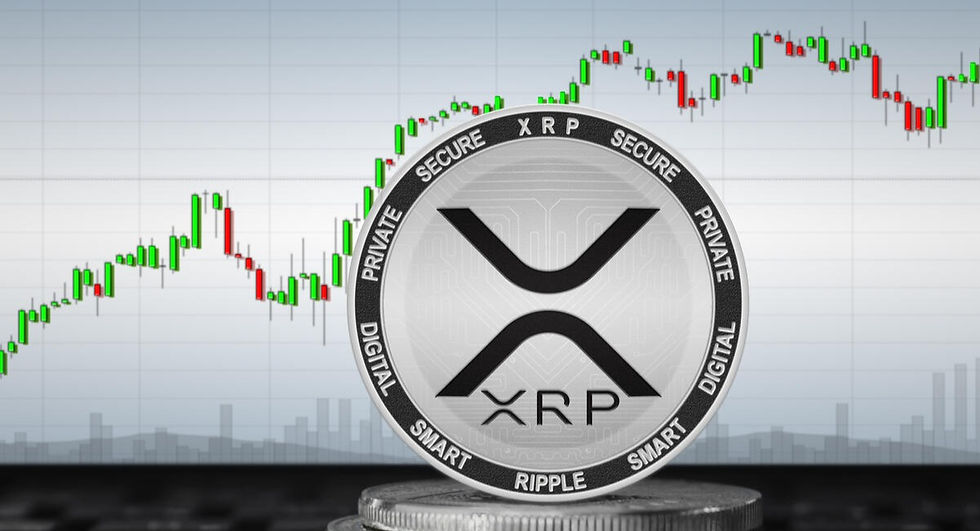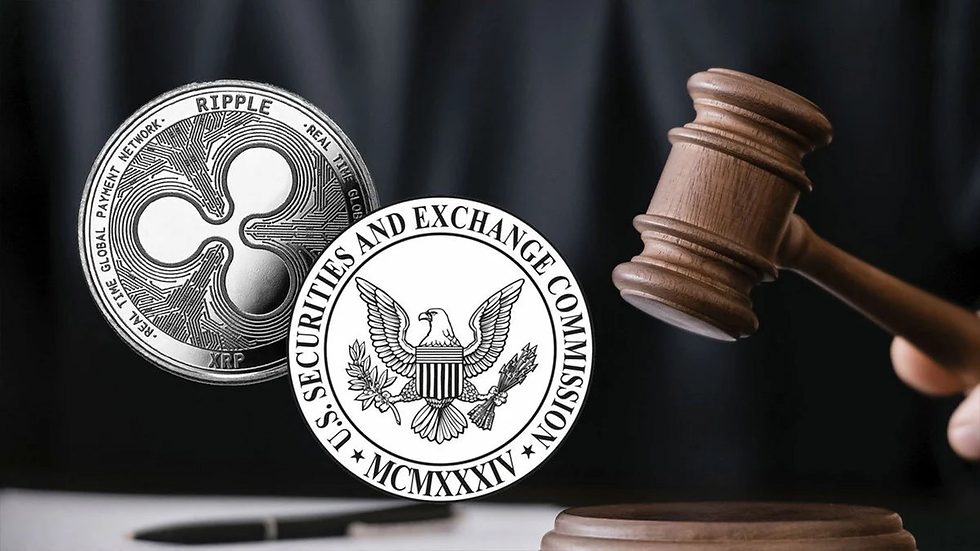Essentially, the outcome of this case will set the precedent for all future cases pertaining to crypto companies attempting to put their tokens on exchanges.
Background
Ripple Labs first appeared on the FinTech landscape in 2012 with a reassuring promise to provide financial institutions with low-cost and speedy clearance of cross-border money transfers. To make it happen, the business created the RippleNet network, on which transactions in the form of a cryptocurrency called XRP can be settled and cleared in real time.
Over several years, however, XRP grew outside of its stated application. The company’s founders used XRP to raise funds in 2013. As a result, the United States Securities and Exchange Commission (S.E.C.) filed a lawsuit against Ripple Labs and its current and previous CEOs in 2020.

Why did the S.E.C. sue Ripple?
The S.E.C. alleged that the executives held an initial public offering (IPO) of XRP, which was an unregistered security at the time. According to the complaint, Ripple raised funds by selling XRP tokens to investors in the United States and worldwide. Additionally, Ripple offered billions of XRP tokens in exchange for non-cash services like market-making and labour.
The lawsuit alleges that Chris Larsen, co-founder and former CEO of Ripple Labs, along with Brad Garlinghouse, Ripple’s current CEO, engaged in personal unregistered XRP transactions worth approximately $600 million.
Moreover, the suit alleged the defendants failed to register their XRP offers and sales, or meet any exemption from registration in violation of the federal securities laws’ registration restrictions.
In other words, the S.E.C. claimed that XRP is a security and defendants sold $600 million worth, without a securities licence.
Generally, a security is a traded financial instrument representing ownership in a corporation or similar entity that has no utility. For instance, publicly listed firms commonly define shares as securities to obtain financing.
Since XRP tokens were used to fund Ripple’s platform, which facilitates money transfers for retailers and not a share in the Ripple Labs company, a civil action was filed at the end of December 2020. The sales of XRP also enriched the platform’s management. However, it is important to note that, as per the SEC, Bitcoin is not a security and does the very same thing.
How do you determine if XRP is a Security?
The S.E.C. vs. W.J. Howey Co. was a landmark Supreme Court case in 1946 that aids in determining whether a transaction falls within the Securities Act of 1933’s definition of an investment contract.
According to the Howey test, the investor’s control over the profit is critical in determining whether an investment contract is a security. It is usually considered a security if the investors have no influence over the asset. So, did XRP comply with the requirements of the Howey test?
The Howey test consists of four elements. According to the test, a transaction is a security if it is (1) an investment of money, (2) in a common enterprise, (3) with the expectation of profit, or (4) to be derived from the efforts of others.
The S.E.C. determined that XRP satisfied the Howey test requirements because (1) Ripple Labs sold $1.38 billion worth of XRP tokens. (2) XRP was purchased by investors who assumed that they were investing in a joint venture. (3) Due to Ripple’s marketing efforts and supply manipulation, investors believed that the price of XRP would climb due to the company's activities (Number 4).
So, on December 21st 2020 the S.E.C. filed A lawsuit against Ripple Labs Inc.
Ripple’s Response to the S.E.C. Lawsuit
While the S.E.C. often opts for settlements in its lawsuits, Ripple took a different approach by engaging in a legal battle instead of complying with the S.E.C.’s demands and paying penalties.
Ripple’s lawyers claimed that the S.E.C. never warned the organization that the U.S. regulator might consider XRP could be classified as a security.
As a result, Ripple believed the S.E.C. was biased when applying the security concept to XRP. If this is found to be true, the commission’s authority will be weakened, along with the credibility of its argument.
Ripple has specifically mentioned some of the links S.E.C. members have had with other crypto platforms, namely Ethereum. While there is no proof of these links, the commission gave Ethereum a pass on securities legislation, saying that it operates in a decentralized manner. Something XRP does as well.
In instances where court proceedings have taken place, the S.E.C. has found favour, as judges have concurred that the crypto assets in question were securities. Unlike commodities, securities are subject to strict regulations, making it necessary to register with the S.E.C. so they can disclosure and educate investors about potential risks.

The Series of Events During the Ripple vs. S.E.C. Lawsuit
Dec. 21, 2020: S.E.C. files lawsuit against Ripple Labs
The S.E.C. initiated legal action against Ripple Labs, its CEO Brad Garlinghouse, and co-founder Chris Larsen, accusing them of conducting an unregistered securities offering. Despite the S.E.C.’s demands, Garlinghouse declared Ripple’s intention to defend itself in the court case.
Dec. 28, 2020: XRP delisted by Coinbase
Coinbase, a prominent cryptocurrency exchange, announced the delisting of the XRP token from its platform.
March 3, 2021: Larsen and Garlinghouse challenge S.E.C.’s fair notice
Larsen and Garlinghouse submitted letters to the court arguing that the S.E.C. lacked fair notice regarding the classification of XRP as a security. They raised concerns about the S.E.C.’s alleged failure to provide clear guidance to market participants.
March 8, 2021: S.E.C. requests an immediate hearing
In response to Larsen and Garlinghouse’s arguments, the S.E.C. requested an immediate hearing from the judge to address the fair notice issue and other matters related to the case.
March 22, 2021: XRP token determined to have currency value and utility
Judge Sarah Netburn ruled that XRP possesses currency value and utility, differentiating it from cryptocurrencies like Bitcoin and Ethereum. This ruling marked a notable development in the case and highlighted the distinction between various digital assets.
April 13, 2021: Token Safe Harbor Proposal 2.0 published
S.E.C. Commissioner Hester Peirce published the Token Safe Harbor Proposal 2.0. This proposal aimed to give developers a three-year grace period, exempting them from securities laws, to better understand their involvement in decentralized networks. A clear acknowledgement that (DeFi) Decentralised Finance is the future and they can’t file lawsuits against everyone.
June 14, 2021: S.E.C.’s internal crypto trading policies deadline extended
The court extended the S.E.C.’s deadline for disclosing its internal crypto trading policies to Aug. 31, 2021. This extension allowed more time for the S.E.C. to reveal its internal workings regarding cryptocurrency trading and potential conflicts of interest.
Aug. 31, 2021: S.E.C.’s internal crypto trading policies disclosure deadline
As per the extended deadline, the S.E.C. was required to disclose its internal crypto trading policies. This disclosure aimed to shed light on the S.E.C.’s operations and their potential impact on the case.
Oct. 15, 2021: Expert discovery deadline
The expert discovery deadline was set for gathering opinions from experts in cryptography and securities. This process aimed to provide additional insights and expert perspectives on the case.
Jan. 24, 2022: Extension granted for sensitive document disclosure
Judge Netburn gave the S.E.C. until Feb. 17 to appeal her earlier decision requiring Ripple Labs to disclose certain sensitive government documents.
Sept. 17, 2022: S.E.C. and Ripple Labs file initial motions for summary judgment
Both the S.E.C. and Ripple Labs submitted their initial motions for summary judgment, marking a significant step in the legal proceedings. These motions outlined each party’s arguments and positions regarding the case.
Sept. 21, 2022: Chamber of Digital Commerce granted permission to file amicus curiae brief
The court reviewed and granted a request from the Chamber of Digital Commerce — an American advocacy group for blockchain technology — to file an amicus curiae brief. A amicus curiae brief is a written submission to a court in which an amicus curiae (literally a “friend of the court:” a person or organization who/which is not party to the proceedings) can set out legal arguments and recommendations in a given case.
Dec. 2, 2022: Reply to summary judgment motions made public
After the Nov. 30 deadline, the S.E.C. and Ripple Labs’ replies supporting their summary judgment motions were made public. These documents provided additional insights into the parties’ legal arguments and responses to the opposing party’s motion.
Dec. 22, 2022: S.E.C. attempts to prevent public release of Hinman documents
The S.E.C. applied to prevent the release of the Hinman documents in the XRP lawsuit, including any references to them in court papers submitted by Ripple Labs.
The Hinman documents pertain to internal S.E.C. communications regarding a speech delivered by former director William Hinman in 2018. During the speech, Hinman said that Ether (ETH), one of the largest cryptocurrencies, should not be categorized as a security. The emails between Hinman and other senior members of the S.E.C. describe why, the reasoning was very flawed. While the Hinman Documents wouldn’t directly help Ripple Labs case, it would go a long way to discredit the S.E.C.
June 12, 2023: Hinman documents unsealed and made public
After a prolonged legal process, the Hinman documents were finally unsealed and made publicly available. The public availability of the Hinman documents added a new dimension to the ongoing legal battle.
July 13, 2023: Ripple Labs wins the case
Judge Torres ruled that Ripple did not break the law when XRP was sold on public exchanges. Thus declaring that XRP was a commodity like Bitcoin. The cryptocurrency sector scored a success in its legal struggles with U.S. regulators.
However, the decision was not entirely in the industry’s favor because Ripple was found to have broken the securities laws when it offered XRP to hedge funds and other institutional buyers. To do that you need licenses from the S.E.C.

Is the XRP lawsuit over?
It is a partial victory for both parties. Judge Torres concluded that the $728.9 million in XRP sales made by the business to hedge funds and other institutional customers constituted unregistered sales of securities, giving the S.E.C. a partial victory.
It’s likely a settlement with the S.E.C. to resolve the outstanding issues will happen for Ripple Labs Inc. However, the overall verdict in the lawsuit might have wider ramifications for how cryptocurrencies and other digital assets are regulated. It might serve as a model for how similar regulatory proceedings against crypto firms can be handled in the future.
Conclusion
If this was a political race both parties would claim victory. Depending on which side of the fence you sit on, you can probably say you won. Gary Gensler and the S.E.C. claimed that Ripple Labs made a billion dollars worth of XRP sales to institutional customers and they were proved correct with judge Torres 's ruling.
Ripple Labs will believe that they won because they got their XRP token deemed not a security. They will ultimately have to pay a large fine to the S.E.C. to stop the inevitable appeals.
The real victory is for the industry. Ripple Labs took one for the team. Finally, we have a precedent now. And that precedent, in conjunction with the Howey Test, says that although it is an investment of money to buy a token and it is in a common enterprise, you cannot expect profit from speculation, nor is it derived from the efforts of others. Hence, from now on, purchasing a cryptocurrency token will be purchasing a commodity. Allowing less regulation of the transfer and storage of wealth, which was ultimately the dream of Satoshi Nakamoto, the creator of Bitcoin.
Disclaimer - None of what is written on this website is financial advice and only descriptions of how the author trades and for entertainment purposes.


コメント